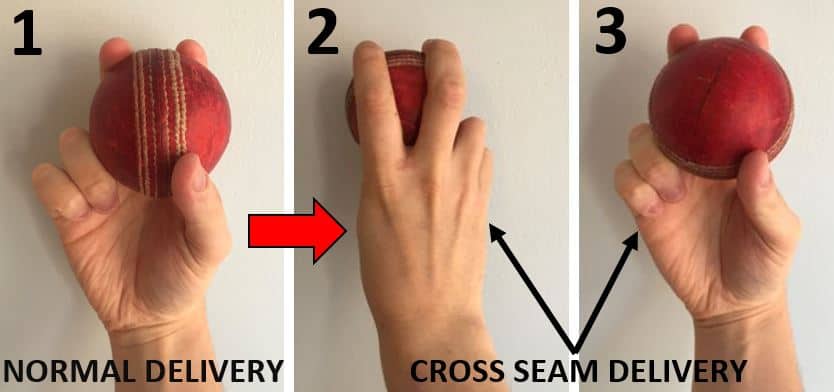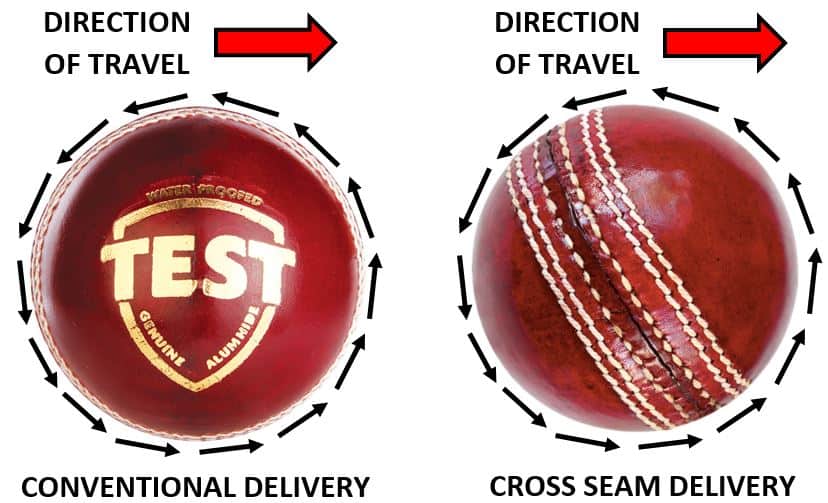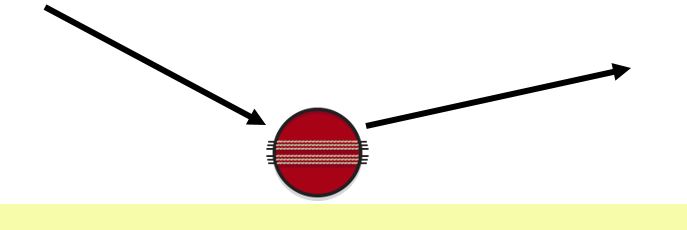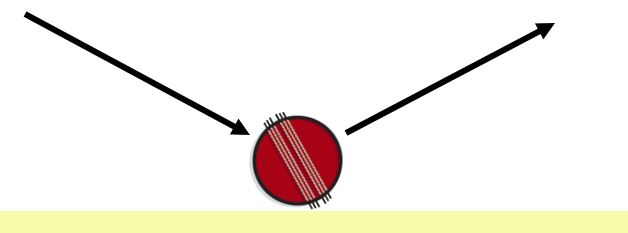Cricket is a complex game, with many different tricks and techniques that players can use to gain an advantage over their opponents. When you first get interested in cricket, you will have a basic understanding of how the game works. The bowler bowls the ball towards the batsman, who will attempt to hit it and score runs. As you start to understand more about the sport, you will notice that bowlers will use different types of deliveries to force batsmen into mistakes. One of these deliveries is known as the ‘cross seam delivery’. In this post, I’m going to explain what this delivery looks like and how you can bowl it. I’m also going to explain why it’s effective, and the situations where it is most useful!
So, what is a cross seam delivery?
A cross seam delivery is a type of variation that a fast bowler will use to try to make the ball bounce in an unusual way. Instead of gripping the ball with the seam running parallel to the fingers, the bowler will turn the ball in the hand so that the seam runs horizontally across their fingers.
There’s the basic summary of what the cross seam delivery is. If you want more information that will help you bowl the delivery effectively, make sure you keep reading!
What Grip Is Used For The Cross Seam Delivery?
As I’ve already mentioned, the grip for the cross seam delivery is very similar to the conventional fast bowling grip. The only difference is that this one requires you to adjust the position of the ball slightly in your hand.
Picture number 1 below shows the conventional fast bowling grip for a right arm bowler. You can see that with this grip, the seam is running parallel with my fingers. From this position, to switch to the cross seam grip, all you have to do is rotate the ball 90 degrees in your hand so the seam is running horizontally across your fingers. You can see the cross seam grip in picture 2 and 3 below. Picture 2 shows the grip from the back of the hand view, while picture 3 shows the grip from the front of the hand view

How To Bowl The Cross Seam Delivery
This is the easy part! The great thing about the cross seam delivery is that you don’t have to do anything special or change your action or your release in any way. All you have to do is go through your normal run up, reach the crease, get your front foot behind the popping crease and release the ball towards the batsman. It literally couldn’t be simpler!
Why Is The Cross Seam Delivery So Effective?
The cross seam delivery is used by so many bowlers because it can cause the ball to bounce in unpredictable ways. To explain this, we’re going to have to talk about the normal style of fast bowling first.
When a fast bowler is bowling normally, they will propel the ball towards the batsman using the conventional fast bowling grip. This means that ideally, the seam on the ball will remain in an upright, vertical position until it lands on the pitch. If the bowler bowls this ball correctly, and the ball makes contact with the pitch with the seam in this upright position, there is a large chance that some sideways movement will occur. This is often referred to as ‘seam movement’. Seam movement may cause the ball to suddenly dart in towards the batsman’s pads, or it may cause the ball to dart away from the batsman. If the ball moves off the pitch in this way, it is incredibly hard for batsmen to deal with because they have so little time to react to the sudden change in trajectory!
So, what’s the difference between what I just described and the cross seam delivery? With the cross seam delivery, the ball doesn’t travel towards the batsman with the seam in an upright position. Instead, the seam will be scrambled and will rotate rapidly. The diagrams below show the difference in how the two types of delivery rotate in the air.

From the diagrams above, you can see the differences in seam position between the two deliveries. The conventional fast bowling delivery on the left will rotate in line with the seam. This makes the seam look like it is staying perfectly still as the ball moves through the air. The cross seam delivery features the seam in a different position, and this means that as it travels through the air the ball will rotate perpendicular to the seam. This is what makes the seam look ‘scrambled’ as the ball rotates. This difference in seam position means that each ball can behave in different ways when they hit the pitch.
When a cross seam delivery hits the pitch, there are generally two things that can happen:
- The smooth side of the ball makes contact with the pitch – This can be seen in the diagram below. Because the side of the ball is a lot smoother than the seam, there is a large chance that the ball will skid on towards the batsman if this part of the ball makes contact with the pitch first. This may result in the batsman being slightly late on their shot because the ball gets to them slightly quicker than expected, but it could also mean that the ball bounces slightly less than usual. If either of these things happen, it will be tough for the batsman to deal with.

- The seam makes contact with the pitch – You can see what this might look like in the diagram below. The seam is the part of the ball that is most raised, so if the ball lands on the seam when the bowler bowls a cross seam delivery, the ball is likely to slow down a lot or bounce a little bit more than usual. If the ball made contact with the ground in the exact way that I’ve shown below, the seam would get caught in the pitch slightly, which would mean it would travel towards the batsman much more slowly. This could lead to them being too early with their shot!

So, to summarise, the cross seam delivery is used by bowlers because now and again it will cause the ball to behave weirdly as it makes contact with the pitch. If the cross seam delivery causes the ball to skid on to the batsman a little, or if it gets stuck in the pitch and slows down a bit, this can force batsmen into mistakes. Additionally, the batsman has no way of knowing when this will happen, which makes it even more dangerous – it is an entirely natural variation. I think that this is the most effective type of variation because if you (the bowler) doesn’t know when the ball is going to misbehave, then the batsman has no chance of working it out!
When Should You Use The Cross Seam Delivery?
Now you know what the cross seam delivery is and how it works, some of you may be wondering when the cross seam delivery should be bowled – and I think that’s an excellent question!
There are a few specific situations in which you will usually see bowlers use this delivery, and I’ll explain them for you here:
- When There’s No Movement in the Air – When the ball isn’t swinging, fast bowlers will have to get creative and search for other ways to take wickets. The cross seam delivery is great for this kind of situation as it can play with a batsman’s timing and put doubt into their mind due to uneven bounce
- When There’s Too Much Movement in the Air – Sometimes the ball is swinging so much that it becomes almost impossible for the batsman to edge it! If the ball is swinging a lot, a batsman can leave the ball a lot more comfortably than if it is only swinging an average amount. Large amounts of swing also make it very hard for the bowler to control their lines and lengths. In these situations, the cross seam delivery can be effective as it is a ball that doesn’t swing. It will allow you to regain control of your line and length, and could surprise the batsman if they are expecting the ball to spin.
- If the Pitch Has Cracks In It – If you’re playing on a pitch that is cracking up, the cross seam delivery can be a huge threat to a batsman. This is especially true if there are large cracks running horizontally across the pitch. Landing the cross seam delivery in one of these cracks could cause the ball to explode up towards the batsman’s head, or it could cause it to shoot low along the ground – potentially catching them LBW. If you can get one cross seam delivery to behave strangely by targeting a crack, it will put huge levels of uncertainty in the mind of the batsman. This could lead to them making mistakes when playing normal deliveries!
- If the Ball is Slippery – There will be times in cricket when you have to bowl with a damp ball. No fast bowler enjoys this, and it becomes much more likely that the ball could slip out of your hand as you release it. This is especially true when you use the conventional fast bowling grip, due to the fact that your fingers will be positioned on the flat part of the ball. By using the cross seam grip and bowling the ball in this way it allows you to get a good grip on the seam, which should help the ball to leave your hand a little more reliably!
Conclusion
The cross seam delivery is an excellent tool and should be part of every fast bowler’s armoury! As we’ve discussed, it’s incredibly easy to use and doesn’t require you to alter your bowling action in any way. Most professional fast bowlers use it, especially when bowling conditions aren’t in their favour, as it gives them that extra wicket taking option.
